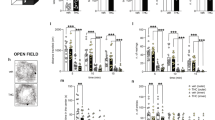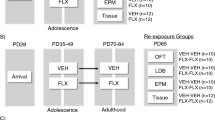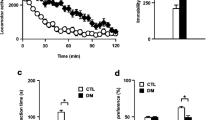Abstract
We recently demonstrated that Δ9-tetrahydrocannabinol (THC) chronic administration in female adolescent rats induces alterations in the emotional circuit ending in depressive-like behavior in adulthood. Since cognitive dysfunction is a major component of depression, we assessed in these animals at adulthood different forms of memory. Adolescent female rats were treated with THC or its vehicle from 35 to 45 post-natal days (PND) and left undisturbed until their adulthood (75 PND) when aversive and spatial memory was assessed using the passive avoidance and radial maze tasks. No alteration was found in aversive memory, but in the radial maze THC pre-treated animals exhibited a worse performance than vehicles, suggesting a deficit in spatial working memory. To correlate memory impairment to altered neuroplasticity, level of marker proteins was investigated in the hippocampus and prefrontal cortex, the most relevant areas for learning and memory. A significant decrease in synaptophysin and PSD95 proteins was found in the prefrontal cortex of THC pre-treated rats, with no alterations in the hippocampus. Finally, proteomic analysis of the synapses in the prefrontal cortex revealed the presence of less active synapses characterized by reduced ability in maintaining normal synaptic efficiency. This picture demonstrates the presence of cognitive impairment in THC-induced depressive phenotype.





Similar content being viewed by others
References
Anisman H, Matheson K (2005) Stress, depression, and anhedonia: caveats concerning animal models. Neurosci Biobehav Rev 29:525–546
Bailey CH, Kandel ER (1993) Structural changes accompanying memory storage. Annu Rev Physiol 55:397–426
Beasley CL, Pennington K, Behan A, Wait R, Dunn MJ, Cotter D (2006) Proteomic analysis of the anterior cingulate cortex in the major psychiatric disorders: evidence for disease-associated changes. Proteomics 6:3414–3425
Beck AT, Weissman A, Kovacs M (1976) Alcoholism, hopelessness and suicidal behavior. J Stud Alcohol 37:66–77
Billups B, Forsythe ID (2002) Presynaptic mitochondrial calcium sequestration influences transmission at mammalian central synapses. J Neurosci 22:5840–5847
Bindokas VP, Lee CC, Colmers WF, Miller RJ (1998) Changes in mitochondrial function resulting from synaptic activity in the rat hippocampal slice. J Neurosci 18:4570–4587
Boyd-Kimball D, Castegna A, Sultana R, Poon HF, Petroze R, Lynn BC, Klein JB, Butterfield DA (2005) Proteomic identification of proteins oxidized by Abeta(1–42) in synaptosomes: implications for Alzheimer’s disease. Brain Res 1044:206–215
Bracchi-Ricard V, Brambilla R, Levenson J, Hu WH, Bramwell A, Sweatt JD, Green EJ, Bethea JR (2008) Astroglial nuclear factor-kappaB regulates learning and memory and synaptic plasticity in female mice. J Neurochem 104:611–623
Braida D, Sacerdote P, Panerai AE, Bianchi M, Aloisi A, Iosuè S, Sala M (2004) Cognitive function in young and adult IL (interleukin)-6 deficient mice. Behav Brain Res 153:423–429
Butterfield DA, Gnjec A, Poon HF, Castegna A, Pierce WM, Klein JB, Martins RN (2006) Redox proteomics identification of oxidatively modified brain proteins in inherited Alzheimer’s disease: an initial assessment. J Alzheimers Dis 10:391–397
Calupca MA, Prior C, Merriam LA, Hendricks GM, Parsons RL (2001) Presynaptic function is altered in snake K+-depolarized motor nerve terminals containing compromised mitochondria. J Physiol 532:217–227
Carmignoto G (2000) Reciprocal communication system between astrocytes and neurones. Prog Neurobiol 62:561–581
Castegna A, Aksenov M, Aksenova M, Thongboonkerd V, Klein JB, Pierce WM, Booze R, Markesbery WR, Butterfield DA (2002a) Proteomic identification of oxidatively modified proteins in Alzheimer’s disease brain. Part I: creatine kinase BB, glutamine synthase, and ubiquitin carboxy-terminal hydrolase L-1. Free Radic Biol Med 33:562–571
Castegna A, Aksenov M, Thongboonkerd V, Klein JB, Pierce WM, Booze R, Markesbery WR, Butterfield DA (2002b) Proteomic identification of oxidatively modified proteins in Alzheimer’s disease brain. Part II: dihydropyrimidinase-related protein 2, alpha-enolase and heat shock cognate 71. J Neurochem 82:1524–1532
Cha YM, White AM, Kuhn CM, Wilson WA, Swartzwelder HS (2006) Differential effects of delta 9-THC on learning in adolescent and adult rats. Pharmacol Biochem Behav 83:448–455
Cha YM, Jones KH, Kuhn CM, Wilson WA, Swartzwelder HS (2007) Sex differences in the effects of Δ9 tetrahydrocannabinol on spatial learning in adolescent and adult rats. Behav Pharmacol 18:563–569
Choi J, Levey AI, Weintraub ST, Rees HD, Gearing M, Chin LS, Li L (2004) Oxidative modifications and down-regulation of ubiquitin carboxyl-terminal hydrolase L1 associated with idiopathic Parkinson’s and Alzheimer’s diseases. J Biol Chem 279:13256–13264
Coles ME, Heimberg RG (2002) Memory biases in the anxiety disorders: current status. Clin Psychol Rev 22:587–627
David G, Barrett EF (2000) Stimulation-evoked increases in cytosolic [Ca(2+)] in mouse motor nerve terminals are limited by mitochondrial uptake and are temperature-dependent. J Neurosci 20:7290–7296
David G, Barrett EF (2003) Mitochondrial Ca2+ uptake prevents desynchronization of quantal release and minimizes depletion during repetitive stimulation of mouse motor nerve terminals. J Physiol 548:425–438
Feldmann RE Jr, Maurer MH, Hunzinger C, Lewicka S, Buergers HF, Kalenka A, Hinkelbein J, Broemme JO, Seidler GH, Martin E, Plaschke K (2008) Reduction in rat phosphatidylethanolamine binding protein-1 (PEBP1) after chronic corticosterone treatment may be paralleled by cognitive impairment: a first study. Stress 11:134–147
Fernandez SM, Frick KM (2004) Chronic oral estrogen affects memory and neurochemistry in middle-aged female mice. Behav Neurosci 118:1340–1351
Glantz LA, Lewis DA (1997) Reduction of synaptophysin immunoreactivity in the prefrontal cortex of subjects with schizophrenia. Regional and diagnostic specificity. Arch Gen Psychiatry 54:943–952
Heffner TG, Hartman JA, Seiden LS (1980) A rapid method for the regional dissection of the rat brain. Pharmacol Biochem Behav 13:453–456
Honer WG (1999) Assessing the machinery of mind: synapses in neuropsychiatric disorders. J Psychiatry Neurosci 24:116–121
Huttner WB, Schiebler W, Greengard P, De Camilli P (1983) Synapsin I (protein I), a nerve terminal-specific phosphoprotein. III. Its association with synaptic vesicles studied in a highly purified synaptic vesicle preparation. J Cell Biol 96:1374–1388
Ikemoto A, Bole DG, Ueda T (2003) Glycolysis and glutamate accumulation into synaptic vesicles. Role of glyceraldehyde phosphate dehydrogenase and 3-phosphoglycerate kinase. J Biol Chem 278:5929–5940
Ishimaru H, Casamenti F, Uéda K, Maruyama Y, Pepeu G (2001) Changes in presynaptic proteins, SNAP-25 and synaptophysin, in the hippocampal CA1 area in ischemic gerbils. Brain Res 903:94–101
Izaki Y, Takita M, Akema T (2008) Specific role of the posterior dorsal hippocampus-prefrontal cortex in short-term working memory. Eur J NeuroSci 27:3029–3034
Jacobs DI, van Rijssen MS, van der Heijden R, Verpoorte R (2001) Sequential solubilization of proteins precipitated with trichloroacetic acid in acetone from cultured Catharanthus roseus cells yields 52% more spots after two-dimensional electrophoresis. Proteomics 1:1345–1350
Karson CN, Mrak RE, Schluterman KO, Sturner WQ, Sheng JG, Griffin WS (1999) Alterations in synaptic proteins and their encoding mRNAs in prefrontal cortex in schizophrenia: a possible neurochemical basis for ‘hypofrontality’. Mol Psychiatry 4:39–45
Kato T (2006) The role of mitochondrial dysfunction in bipolar disorder. Drug News Perspect 19:597–602
Klysik J, Theroux SJ, Sedivy JM, Moffit JS, Boekelheide K (2008) Signaling crossroads: the function of Raf kinase inhibitory protein in cancer, the central nervous system and reproduction. Cell Signal 20:1–9
Konradi C, Eaton M, MacDonald ML, Walsh J, Benes FM, Heckers S (2004) Molecular evidence for mitochondrial dysfunction in bipolar disorder. Arch Gen Psychiatry 61:300–308 (Erratum in: Arch Gen Psychiatry 61:53)
Lee J, Folley BS, Gore J, Park S (2008) Origins of spatial working memory deficits in schizophrenia: an event-related FMRI and near-infrared spectroscopy study. PLoS ONE 3:e1760
Love S, Siew LK, Dawbarn D, Wilcock GK, Ben-Shlomo Y, Allen SJ (2006) Premorbid effects of APOE on synaptic proteins in human temporal neocortex. Neurobiol Aging 27:797–803
Ly CV, Verstreken P (2006) Mitochondria at the synapse. Neuroscientist 12:291–299
Maki M, Matsukawa N, Yuasa H, Otsuka Y, Yamamoto T, Akatsu H, Okamoto T, Ueda R, Ojika K (2002) Decreased expression of hippocampal cholinergic neurostimulating peptide precursor protein mRNA in the hippocampus in Alzheimer disease. J Neuropathol Exp Neurol 61:176–185
Mathews A, MacLeod C (2005) Cognitive vulnerability to emotional disorders. Annu Rev Clin Psychol 1:167–195
McCann DJ, Rabin RA, Rens-Domiano S, Winter JC (1989) Phencyclidine/SKF-10,047 binding sites: evaluation of function. Pharmacol Biochem Behav 32:87–94
McIntyre RS, Soczynska JK, Konarski JZ, Woldeyohannes HO, Law CW, Miranda A, Fulgosi D, Kennedy SH (2007) Should depressive syndromes be reclassified as “metabolic syndrome type II”? Ann Clin Psychiatry 19:257–264
McNay EC, Fries TM, Gold PE (2000) Decreases in rat extracellular hippocampal glucose concentration associated with cognitive demand during a spatial task. Proc Natl Acad Sci USA 97:2881–2885
Migaud M, Charlesworth P, Dempster M, Webster LC, Watabe AM, Makhinson M, He Y, Ramsay MF, Morris RG, Morrison JH, O’Dell TJ, Grant SG (1998) Enhanced long-term potentiation and impaired learning in mice with mutant postsynaptic density-95 protein. Nature 396:433–439
Moser MB (1999) Making more synapses: a way to store information? Cell Mol Life Sci 55:593–600
Murphy DD, Segal M (1996) Regulation of dendritic spine density in cultured rat hippocampal neurons by steroid hormones. J Neurosci 16:4059–4068
NIDA (2005) NIDA research monograph series: marijuana abuse. NIH, Bethesda
O’Shea M, Singh ME, McGregor IS, Mallet PE (2004) Chronic cannabinoid exposure produces lasting memory impairment and increased anxiety in adolescent but not adult rats. J Psychopharmacol 18:502–508
O’Shea M, McGregor IS, Mallet PE (2006) Repeated cannabinoid exposure during perinatal, adolescent or early adult ages produces similar long- lasting deficits in object recognition and reduced social interaction in rats. J Psychopharmacol 20:611–621
Owen J 18/3/2007 Cannabis: an apology. The Independent on Sunday, UK
Perrone-Bizzozero NI, Sower AC, Bird ED, Benowitz LI, Ivins KJ, Neve RL (1996) Levels of the growth-associated protein GAP-43 are selectively increased in association cortices in schizophrenia. Proc Natl Acad Sci USA 93:14182–14187
Pope HG Jr, Jacobs A, Mialet JP, Yurgelun-Todd D, Gruber S (1997) Evidence for a sex-specific residual effect of cannabis on visuospatial memory. Psychother Psychosom 66:179–184
Pozzo-Miller LD, Inoue T, Murphy DD (1999) Estradiol increases spine density and NMDA-dependent Ca2+ transients in spines of CA1 pyramidal neurons from hippocampal slices. J Neurophysiol 81:1404–1411
Quinn HR, Matsumoto I, Callaghan PD, Long LE, Arnold JC, Gunasekaran N, Thompson MR, Dawson B, Mallet PE, Kashem MA, Matsuda-Matsumoto H, Iwazaki T, McGregor IS (2008) Adolescent rats find repeated Delta(9)-THC less aversive than adult rats but display greater residual cognitive deficits and changes in hippocampal protein expression following exposure. Neuropsychopharmacology 33:1113–1126
Riha PD, Rojas JC, Colorado RA, Gonzalez-Lima F (2008) Animal model of posterior cingulate cortex hypometabolism implicated in amnestic MCI and AD. Neurobiol Learn Mem 90:112–124
Rubino T, Vigano’ D, Realini N, Guidali C, Braida D, Capurro V, Castiglioni C, Cherubino F, Romualdi P, Candeletti S, Sala M, Parolaro D (2008) Chronic Delta(9)-tetrahydrocannabinol during adolescence provokes sex-dependent changes in the emotional profile in adult rats: behavioral and biochemical correlates. Neuropsychopharmacol 33(11):2760–2771
Rubino T, Realini N, Braida D, Guidi S, Capurro V, Viganò D, Guidali C, Pinter M, Sala M, Bartesaghi R, Parolaro D (2009) Changes in hippocampal morphology and neuroplasticity induced by adolescent THC treatment are associated with cognitive impairment in adulthood. Hippocampus Jan 20. doi:10.1002/hipo.20554
Sala M, Braida D, Calcaterra P, Leone MP, Comotti FA, Gianola S, Gori E (1991) Effect of centrally administered atropine and pirenzepine on radial arm maze performance in the rat. Eur J Pharmacol 194:45–49
SAMHSA (2004) Substance Abuse and Mental Health Service Administration. Results from the 2003 National Survey on Drug Use and Health: National Findings, Office of Applied Studies, NSDUH Series H-25. DHHS, Rockville, MD
Schneider M, Koch M (2003) Chronic pubertal, but not adult chronic cannabinoid treatment impairs sensorimotor gating, recognition memory, and the performance in a progressive ratio task in adult rats. Neuropsychopharmacol 28:1760–1769
Schneider M, Koch M (2005) Deficient social and play behavior in juvenile and adult rats after neonatal cortical lesion: effects of chronic pubertal cannabinoid treatment. Neuropsychopharmacol 30:944–957
Setsuie R, Wada K (2007) The functions of UCH-L1 and its relation to neurodegenerative diseases. Neurochem Int 51:105–111
Siesjo BK (1978) Brain energy metabolism. Wiley, New York, pp 101–130
Sinha P, Poland J, Schnolzer M, Rabilloud T (2001) A new silver staining apparatus and procedure for matrix-assisted laser desorption/ionization-time of flight analysis of proteins after two-dimensional electrophoresis. Proteomics 1:835–840
Solowij N, Battisti R (2008) The chronic effects of cannabis on memory in humans: a review. Curr Drug Abuse Rev 1:81–98
Stone DJ, Rozovsky I, Morgan TE, Anderson CP, Finch CE (1998) Increased synaptic sprouting in response to estrogen via an apolipoprotein E-dependent mechanism: implications for Alzheimer’s disease. J Neurosci 18:3180–3185
Theroux S, Pereira M, Casten KS, Burwell RD, Yeung KC, Sedivy JM, Klysik J (2007) Raf kinase inhibitory protein knockout mice: expression in the brain and olfaction deficit. Brain Res Bull 71:559–567
Touzani K, Puthanveettil SV, Kandel ER (2007) Consolidation of learning strategies during spatial working memory task requires protein synthesis in the prefrontal cortex. Proc Natl Acad Sci USA 104:5632–5637
Urushitani M, Kurisu J, Tateno M, Hatakeyama S, Nakayama K, Kato S, Takahashi R (2004) CHIP promotes proteasomal degradation of familial ALS-linked mutant SOD1 by ubiquitinating Hsp/Hsc70. J Neurochem 90:231–244
Valtorta F, Pennuto M, Bonanomi D, Benfenati F (2004) Synaptophysin: leading actor or walk-on role in synaptic vesicle exocytosis? Bioessays 26:445–453
Viveros MP, Llorente R, Moreno E, Marco EM (2005) Behavioural and neuroendocrine effects of cannabinoids in critical developmental periods. Behav Pharmacol 16:353–362
Wilson PO, Barber PC, Hamid QA, Power BF, Dhillon AP, Rode J, Day IN, Thompson RJ, Polak JM (1988) The immunolocalization of protein gene product 9.5 using rabbit polyclonal and mouse monoclonal antibodies. Br J Exp Pathol 69:91–104
Zenisek D, Matthews G (2000) The role of mitochondria in presynaptic calcium handling at a ribbon synapse. Neuron 25:229–237
Zucker RS (1999) Calcium- and activity-dependent synaptic plasticity. Curr Opin Neurobiol 9:305–313
Acknowledgments
This work was supported by grants from the Italian Governmental Department of Drugs of Abuse and University of Insubria (FAR2007, FAR2008). We wish to thank Michela Matteoli (University of Milan) for her helpful suggestions on neuroplasticity markers.
Author information
Authors and Affiliations
Corresponding author
Rights and permissions
About this article
Cite this article
Rubino, T., Realini, N., Braida, D. et al. The Depressive Phenotype Induced in Adult Female Rats by Adolescent Exposure to THC is Associated with Cognitive Impairment and Altered Neuroplasticity in the Prefrontal Cortex. Neurotox Res 15, 291–302 (2009). https://doi.org/10.1007/s12640-009-9031-3
Received:
Revised:
Accepted:
Published:
Issue Date:
DOI: https://doi.org/10.1007/s12640-009-9031-3




